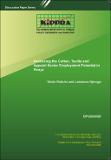Discussion Paper No. 229 of 2020 on Assessing the Cotton, Textile and Apparel Sector Employment Potential in Kenya
View/
Publication Date
20202020
Author
Type
Discussion Paperviews
downloads
Metadata
Show full item recordBy
Malicha Wario & Njoroge Lawrence
Abstract/
Cotton-textile and apparel (CTA) sector is arguably one of the industries with the potential to absorb skilled, semi-skilled, and non-skilled workers within its chain of production. This paper explores the CTA sector value chain in Kenya and specifically aims to pinpoint the segments of the CTA value chain that have the potential to contribute to job creation; identify the key constraints to growth in the CTA value chain; and to identify labour skills requirements to reach the employment potential. The global value chain analysis was employed in the value chain mapping with major nodes of the value chain being identified as cotton growing; ginning; textile milling, spinning, weaving and yarning; export market; and domestic market. Key constraints were identified across the value chain, including low participation of the youth in the lower chain of the CTA value chain, low education attainment of individuals involved in CTA activities, low yields, and low cotton quality and quantity production of cotton lint. Further, low productivity among milling firms, high cost of energy, competition from informal establishments, access to finance, cost of business permit after devolution, unfavourable fabric/apparel import and export trade, importation of firm raw materials, transport, customs, trade regulation and lack of research and development are major constraints in the sector.
Subject/
Cotton Industry; Value Chain Analysis; Informal Establishments; skills gap Analysis
Publisher
The Kenya Institute for Public Policy Research and Analysis (KIPPRA)Series
DP/229/2020Collections
- Discussion Papers [342]

